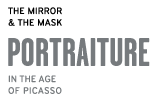
Metaphorical identities
The new figurative idioms that co-existed with abstract informalist movements were responsible for the new images of contemporary man. To create these images artists looked to automatism and expressive freedom derived both from Expressionism and Surrealist automatism. Starting with Picasso’s portraits of Dora Maar, the most violent images within his work, we see the start of a new chapter of tragic and monstrous beauty that functions as the metaphor of new, modern consciousness. This paradigm would be crucial for a series of artists working in the second half of the century who were marked by a widespread feeling of pessimism and angst. They used different modes of distortion and at times of metamorphosing the body: broken up, as in Jean Dubuffet’s paintings, disfigured through violent gestural strokes in Antonio Saura’s figures, distorted and damaged to the point of producing revulsion as in Francis Bacon’s inhuman figures, or even disintegrated, as in Alberto Giacometti’s evanescent figures.
The new figurative idioms that co-existed with abstract informalist movements were responsible for the new images of contemporary man. To create these images artists looked to automatism and expressive freedom derived both from Expressionism and Surrealist automatism. Starting with Picasso’s portraits of Dora Maar, the most violent images within his work, we see the start of a new chapter of tragic and monstrous beauty that functions as the metaphor of new, modern consciousness. This paradigm would be crucial for a series of artists working in the second half of the century who were marked by a widespread feeling of pessimism and angst. They used different modes of distortion and at times of metamorphosing the body: broken up, as in Jean Dubuffet’s paintings, disfigured through violent gestural strokes in Antonio Saura’s figures, distorted and damaged to the point of producing revulsion as in Francis Bacon’s inhuman figures, or even disintegrated, as in Alberto Giacometti’s evanescent figures.

Pablo Picasso
Bust of a Woman with Hat (Dora), 1939
Oil on canvas, 21 5/8 x 18 1/4 in. (55 x 46.5 cm)
Fondation Beyeler, Riehen/Basel, Switzerland

Jean Dubuffet
Bertelé bouquet fleuri, Portrait de Parade
(Bertelé as a Blossoming Bouquet. Sideshow Portrait), 1947
Oil, plaster, and sand on canvas, 45 11/16 x 35 1/16 in. (116 x 89 cm)
National Gallery of Art, Washington D.C.
The Stephen Hahn Family Collection (Partial and Promised Gift)
Bertelé bouquet fleuri, Portrait de Parade
(Bertelé as a Blossoming Bouquet. Sideshow Portrait), 1947
Oil, plaster, and sand on canvas, 45 11/16 x 35 1/16 in. (116 x 89 cm)
National Gallery of Art, Washington D.C.
The Stephen Hahn Family Collection (Partial and Promised Gift)

Francis Bacon
Portrait of George Dyer in a Mirror, 1968
Oil on canvas, 78 x 57 7/8 in. (198 x 147 cm)
Museo Thyssen-Bornemisza, Madrid

















